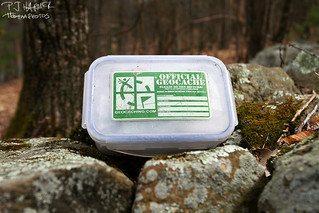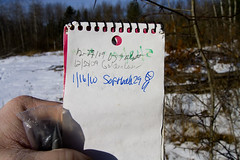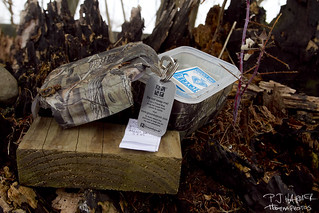There’s hiking trails all over, mountains to climb, bike trails to ride, sports to play, and games to get you out and about.
Geocaching is one of those games.
Several years ago, I had been looking for something to get me outside and active, well more than I already was. It was early 2008 and a friend said he saw something about this game – geocaching. He owned some GPS units, so we decided to give it a try a week or two later.
Despite it being in the middle of the winter, we went at it on a crisp winter afternoon. We found five that day, and I was hooked. I originally posted a bunch of this on my blog a couple of years ago and now I want to share it with others – so that maybe you can also become a geocacher and see the fun in the game. One of the best parts about it is that it’s extremely family friendly. This game can be fun for people of all shapes, sizes, ages and physical abilities. It’s truly a way to get people outdoors and exploring.
What is geocaching?
Simply put, geocaching is a high-tech scavenger hunt. People use GPS receivers (hand-held) or a smart phone (Geocaching.com has an official app) to find something that somebody placed. You could be looking for a large ammo can, a small lock-and-lock container or a nano — which is a small metallic container the circumference of a dime. The containers can be clever or easy.
Remember to sign the log!
Geocaching began in 2000. Most geocachers who have been in the game for a bit know Dave Ulmer as the “father” of the game. He placed the first “geo stash” on May 3, 2000 in Oregon.
He placed a cache and posted the coordinates on a Usenet group. Within three days, it had been found twice. This cache was mostly buried (which is no longer accepted) and contained things such as computer programs, videos, books, a slingshot, money and a can of beans.
The original cache is no longer there, but there is one in its place as well as a plaque commemorating the spot as the place for the first geocache.
The idea of the game is simple. You get the coordinates for a cache. Go find it. From there, the minimum requirement is to sign the log and replace the cache as well or better than you found it. If the cache contains any swag, which is usually just dollar-store items or the like, you can trade things out. But you should always try and trade equal or above value.
How do I play?
First, steer your browser to Geocaching.com. Sign up for a free account. Then, you can search for caches.
(Note: there are some other geocaching sites — such as opencaching.com — but geocaching.com is still considered the No. 1 place to go as it features the most geocaches listed).
At a minimum you need to have some version of a GPS. Garmin is my personal choice, but there are some other good hand-held units out there. With the onset of technology, too, most smartphones can be used for geocaching. Groundspeak — the owners of geocaching.com — have apps available on the iPhone and Droid for geocaching. People have even used their iPads to geocache. That makes life even easier as it can use your location and find the nearest caches. Realize, however, that the GPS in the phones isn’t as good as most hand-held devices.
Ammo cans (usually green) are always a welcomed sight. The gold ones are often placed in honor of someone reaching 1,000 finds.
Basically, after you sign up for an account on Geocaching, you can plug in an address and find caches nearby. Plug those coordinates into your GPS — or use your smartphone — and go find it.
Before you go, however, read the description. Get an idea of what you are looking for. That will make life easier. I would suggest making your first few finds a larger container, so you can see what is out there.
Once you get to the area, start looking. Look for a spot that might hide something. Does anything seem out of place? Check around closely. Don’t always rely on the GPS. Once you are within 10-20 feet, start looking. Coordinates aren’t always going to be perfect as people have different GPS units and the weather could have played havoc when it was originally placed.
One thing to always remember — be aware of the difficulty and terrain ratings listed on the geocache page. Each are numbers 1-5 with one being easy and 5 being the hardest. Keep those in mind when you go searching. When starting out, you should probably keep it at 2.5/2.5 and under for a few caches to keep yourself in it. You don’t want to do the hardest ones, come up short and get disheartened!
Once you find the cache, sign the log. Trade some swag if you wish, but when done, put it back where you found it and make sure it’s hidden!
After that, log your find online. Go to the cache page, leave some comments for the owner and enjoy the game.
It’s that simple.
Types of caches
The following are the ones you’ll likely come across during your geocaching adventures. Note that this is not all the caches, rather ones you’ll come across more than others.
Traditional cache: The original type of cache. It’s, at its most basic, a container and log. They can range in size, so make sure you pay attention to the size listed on the cache page.
Multi-cache: This means there is more than one location. So the first one will lead you to the second, and so forth, until you reach the final. Again, it could be many different sizes — at each stage.
Mystery cache: This is also known as a puzzle cache. Basically, you’ll have to solve or do something — either before or in the field — to get the real coordinates. When you see this, make sure you read the cache page very closely!
Letterbox hybrid cache: Letterboxing is something that pre-dates geocaching. Basically, you get clues on how to find a letterbox. In the end, there’s a stamp that you stamp your book with. The idea is the same here — often these caches are sharing a spot with the letterbox. Stamps are also there. basically a traditional with a different icon.
Event cache: You won’t be finding a container here, rather a bunch of geocachers getting together to hang out, eat or do other things. This is the social aspect of the game and usually a lot of fun.
EarthCache: Again, you won’t find a container. This is something where you’ll have to do some things to learn an Earth science lesson. They can be really easy or quite in-depth. Again, read the cache page so you know what you’ll have to do when you get there!
Virtual cache: Though these can no longer be hidden as they are archived from that, there are many still there to be found. These won’t have a container, but you’ll have to find something or do something (such as take a photo). There are some places (such as Washington D.C.) where there are many of these available to find.
Hiding a cache
I would suggest you find a bunch of caches before placing any. Though it’s tempting to go out and hide some so you can see people find it, the hides are better once you have some finds under your belt and you know you are going to continue the game.
Remember, if you place a cache, you have to maintain it. Once you have found a bunch of caches and want to hide them, check the geocaching website for rules and such.
Other parts of the game
There are some aspects to keep in mind when caching, specifically about the things you might find in a cache.
Geocoins can come in different shapes, sizes and looks. As nice as they are, they usually aren't for keeping (unless you bought them for your personal collection or someone placed it in the cache with the idea of someone getting to keep it!)
Something else to know about are travel bugs and geocoins. These, most of the time, are not keeper items. These are meant to be moved from cache to cache. They get logged on the geocaching website when you find them and then you drop them in another cache and note that when you log the cache.
Pathtags are similar in that they have a tracking code, but usually these are in there as signature items, so you can trade for it and keep it. You should still log it on the Pathtags website as it will show the owner where it was picked up. When you log those, you’re basically putting a tack on a map.

Then there are signature items. These can range from pencils to wooden coins to business cards to artsy things to other items — but they are things that cachers leave behind to show they were there. These can be considered swag and you can trade for these items. A lot of people collect signature items. For me, personally, it’s pretty much the only things I’ll trade for.
There’s the regular swag, too — trinkets, toys, DVDs, books — all sorts of stuff. Sometimes it’s a themed cache. Sometimes it’s normal, cheap swag.
That’s the basics of geocaching. I don’t want to overload anyone with the game. I’ll re-visit this soon and get a little more in-depth on some items. But this should, hopefully, get you rolling on playing the game. If you have questions, post it in a comment or drop me a line!
Most of all, have fun! Geocaching can take you some wonderful spots and hopefully, it will take you to some places you’ve never seen!
P.J. blogs at A ‘lil HooHaa about geocaching, baseball, homebrewing, living with diabetes and countless other topics. Feel free to stop over and say hi!








No comments:
Post a Comment
Thanks for your comment!